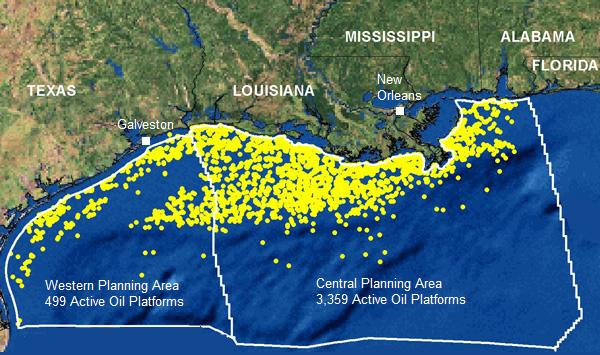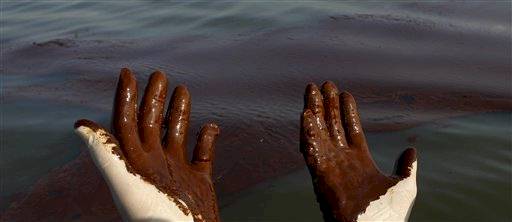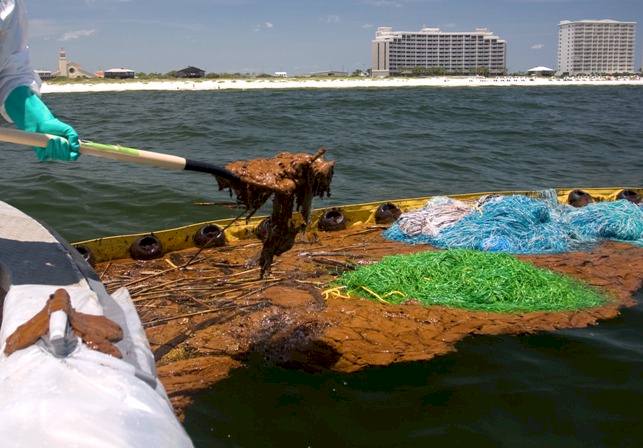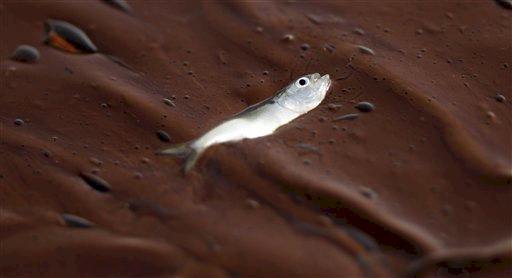100,000 Gallons of Crude Leaking Per Hour into the Atlantic Ocean! Deep-water oil drilling risks damaging our oceans for the sake of having more fossil fuels with which we then damage Earth's atmosphere," says Themis artist Ruffian Angel.The Mexican Gulf Ecological DisasterThe Easy Solutions Failed - Capping and Relief
Drilling Are Under Way
Leak estimates are climbing every two days having reached as high as 60,000 barrels per day mid June. < Previous | Next > BP & Contractors Begin Lengthy Surgical Process
*100,000 Gallons of crude is leaking each hour into the Atlantic Ocean according to estimates. It would seem that off-shore oil drilling risks damaging our oceans for the sake of having more fossil fuels
with which we then damage Earth's atmosphere.
Pursuing a Bush and Obama-Administration initiative for deep-water offshore oil drilling the TransOcean-owned "Deepwater Horizon" drilling rig had been boring the oil well known as MC252 for British Petroleum, located in 5,067 ft of water in United States Coastal waters about 50 miles from the coast of Louisiana. Working with Halliburton Inc., TransOcean Inc. drilling crews were planning to leave the MC252 site in order for another unit, a completion rig, to come into place to take over and prepare the well to go into production. Many things had been going wrong by then (see Explosion No Surprise). After an explosion on 20 April that killed 11 workers aboard the Deepwater Horizon , the rig sunk two days later leaving a tremendous flow of crude gushing from the broken and bent risers that had slid to the bottom of the ocean at the marine well head . Capping a broken, twisted, crude-oil-gushing sea-bed riser is no small feat at depths of roughly one mile below the surface where pressures are crushing. Stopping the thousand-barrel-per-hour flow of oil from a bore that has been drilled almost 4 miles below the ocean floor is just not going to happen except for the absolute luckiest of operators. That's one of the risks that is taken when the greed for oil far exceeds the desire for responsible ecology. British Petroleum (BP) must in fact control the flow and draw it through pipes to container vessels and eventually bring it to market. By June 3, workers at the MC252 (Macondo 252 ) site had tried all the simpler quick-fix options without success. BP's Live Feed From Remotely Operated Vehicles at MC252Capping and controlling some of the flow is the current project while BP moves equipment into place to drill wells into the sea bed to the same pool feeding MC252 (Macondo 252 )from nearby and take the pressure off the out-of-control well. The relief wells are drilled straight down into the sea bottom, parallel to the Macondo 252 well bore for several thousand meters and then angled to intersect the original wellbore at about 4,000 meters below the seafloor. It is expected to take another two months for BP to reach this depth, which is just above the oil reservoir, a subsurface pool of crude and natural gas sandwiched between layers of rock. Meanwhile the process of capping and bleeding off a quantity of oil continues. In a televised address to the U.S. nation, President Obama said on June 15 that 90% of the leak will be captured n a couple of weeks. Some of the oil is being stored ship-board until offloaded to barges and taken to refineries, and thousands of barrels have been burned off on the surface becasue storage capacity has been limited aboard the ships on site. On June 5, the broken mess of twisted riser pipe was cleanly severed from the lower marine riser and all the twisted pipe that had stymied some of the flow. This leaves BP with the full raging flow from the well to deal with but at the same time, a clean diameter upon which to operate. By June 6 , after 3 failed attempts, a quasi-cap was put in place with a channelling riser taking some of the crude, between 5 and 10% of the total leak away from the marine well to the surface. This a leaky, lossy process which is done with a deliberately loose connection between the new riser and the rubber base of the newly placed well-cap. The tecnicians operating robotic arms to perform the job must carefully avoid another explosion which could happen if they contained the leak too fast. Because this capping/relief drilling operation is many-faceted and still in it incipient stages, the flow of crude oil into the ocean at this time is conceivably much worse than it has been at any time since the Deepwater Horizon Explosion. Cleaning up the debris of bent riser pipe which was restricting the leakage has left the well unrestrained. Cutting the nearly two-foot diameter pipe wide open at the lower marine riser unleashes the full force of the man-made volcanic oil gusher and would have increased the now unrestricted marine well-head flow by roughly 15 to 25 % to an estimated 2400 barrels per hour or more, 60 thousand barrels or more per day. It wasn't there before greedy men came along and it shouldn't be in the ocean now. The risk of this happening again and again is real.  Many factors including cold water meeting natural gas creating expanding methyl hydrates make this step the most risky of a long process of cure. After stabilizing the initial junction, relief vents on the sides of the coupling can be closed gradually and sealed. This "clean-up" and capping operation can be improved substantially over time to the point where the leak is completely restricted but the best approach is to take some pressure off the well all the while the laborious capping process continues. In short, the oil leak is getting much worse for the moment.   'Moran Environmental' Contractor Cleaning Up The Crude As It Nears Orange Beach in Alabama Photo © BP p.l.c. In another shocking news item from the Gulf of Mexico, Moran Environmental is keeping out U.S. Non-Governmental Institutions like the Human Society, National Wildlife Society and helpers from all around the world willing to hep save wildlife on a voluntary basis. BP is paying Moran and it doesn't want volunteers poaching its territory. The Unions of workers paid by BP to clean up shore lines have lobbied Washington successfully to have the U.S. coast guard turn away Mexican, Canadian and other ships volunteering to help with the booms and other oil-spill clean-up apparatus. This entire process suggests that the costs to the environment are absurdly high. Deep-water oil drilling risks damaging our oceans for the sake of having more fossil fuels with which to damage Earth's atmosphere.  < Previous | Next > * An estimated 60,000 Barrels per day / 24 = 2500 barrels per hour @ 42 US gals per barrel = 105,000 thousand gallons per hour -Ruffian.Angel at Themismusic.com |


